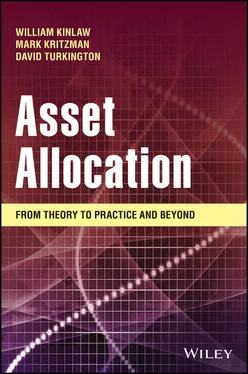Many investors believe that private equity volatility should be much higher than public equity volatility because private equity is more highly levered than public equity.
However, not only is there no discernible relationship between leverage and private equity volatility, it does not exist in the public market either.
Leverage does not appear to affect private equity volatility because private equity managers tend to invest in companies whose underlying business activities are inherently less risky, which cancels out the leverage effect.
The volatility estimated from longer-interval private equity returns is the correct approximation of volatility because it approximates the actual distribution of outcomes realized by private equity investors over longer horizons.
Chapter 12: Necessary Conditions for Mean-Variance Analysis
It is a widely held view that the validity of mean-variance analysis requires that investors have quadratic utility and that returns are normally distributed. This view is incorrect.
For a given time horizon or assuming returns are expressed in continuous units, mean-variance analysis is precisely equivalent to expected utility maximization if returns are elliptically distributed, of which the normal distribution is a more restrictive special case, or (not “and”) if investors have quadratic utility.
For practical purposes, mean-variance analysis is an excellent approx- imation to expected utility maximization if returns are approximately elliptically distributed or investor preferences can be well described by mean and variance.
For intuitive insight into an elliptical distribution, consider a scatter plot of the returns of two asset classes. If the returns are evenly distributed along the boundaries of concentric ellipses that are centered on the average of the return pairs, the distribution is elliptical. This is usually true if the distribution is symmetric, kurtosis is relatively uniform across asset classes, and the correlation of returns is reasonably stable across subsamples.
For a given elliptical distribution, the relative likelihood of any multivariate return can be determined using only mean and variance.
Levy and Markowitz have shown using Taylor series approximations that power utility functions, which are always upward sloping, can be well approximated across a wide range of returns using just mean and variance.
In rare circumstances, in which returns are not elliptical and investors have preferences that cannot be approximated by mean and variance, it may be preferable to employ full-scale optimization to identify the optimal portfolio.
Full-scale optimization is a numerical process that evaluates a large number of portfolios to identify the optimal portfolio, given a utility function and return sample. For example, full-scale optimization can accommodate a kinked utility function to reflect an investor's strong aversion to losses that exceed a chosen threshold.
Asset allocation requires investors to forecast expected returns, standard deviations, and correlations whose values vary over time.
Long-run averages are poor forecasts because they fail to capture this time variation.
But extrapolating from a short sample of recent history is ineffective because it introduces noise and assumes a level of persistence that does not reliably occur.
As an alternative, investors often regress these asset class variables on economic variables to derive forecasts, but this approach may not help because additional variables contribute noise along with information.
The investor's challenge is to maximize the information content and minimize the noise, thereby generating the most reliable predictions.
The prediction from a linear regression equation can be equivalently expressed as a weighted average of the past values of the dependent variable in which the weights are the relevance of the past observations of the independent variables.
Within this context, relevance has a precise mathematical meaning. It is the sum of statistical similarity and informativeness.
Statistical similarity equals the negative of the Mahalanobis distance of the past values for the independent variables from their current values, and informativeness equals the Mahalanobis distance of the past values of the independent variables from their average values. In other words, prior periods that are more like the current period but different from the historical average are more relevant than those that are not.
Investors may be able to improve the reliability of their forecasts by filtering historical observations for their relevance and using this mathematical equivalence to produce new forecasts.
Chapter 14: The Stock–Bond Correlation
Investors rely on the stock–bond correlation to construct optimal portfolios and to assess risk.
Investors should care less about how stocks and bonds co-move from month to month as they do about their co-movement over the duration of their investment horizon.
The most common approach to estimating the longer-term correlation of stocks and bonds is to extrapolate the correlation of monthly returns over a prior period. This approach is decidedly unreliable, because the autocorrelations and lagged cross-correlations of stock and bond returns are nonzero.
As an alternative, investors may consider estimating the stock–bond correlation from longer-horizon returns, but this approach is unreliable because the stock–bond correlation varies over time.
To address these problems, this chapter introduces the notion of a single-period correlation that measures the extent to which stock and bond returns move synchronously or drift apart over the course of the investment horizon.
In addition, this chapter introduces several fundamental variables to predict the longer-horizon stock–bond correlation, some of which are expressed as paths rather than as single-period average values.
This chapter also describes how to filter historical observations for their historical relevance, as discussed more fully in Chapter 13.
Together, these innovations significantly improve the reliability of the forecast of the stock–bond correlation.
Investors constrain their allocation to certain asset classes because they do not want to perform poorly when other investors perform well.
Constraints are inefficient because, of necessity, they are arbitrary.
Investors can derive more efficient portfolios by expanding the optimization objective function to include aversion to tracking error as well as aversion to absolute risk.
Mean-variance-tracking error optimization produces an efficient surface in the dimensions of expected return, standard deviation, and tracking error.
This approach usually delivers a portfolio that is more efficient in three dimensions than the portfolio that is produced by constrained mean-variance analysis.
Chapter 16: Asset Allocation Versus Factor Investing
Some investors prefer to construct portfolios from asset classes because asset classes are readily observable and directly investable.
Other investors prefer to allocate to factors because they believe asset classes are defined arbitrarily and do not capture the fundamental determinants of performance as directly as factors do. Also, some factors carry risk premiums that are not directly available from asset classes.
Investors can have it both ways by continuing to invest in asset classes but augmenting the Markowitz objective function to include a term that penalizes deviation from a desired factor profile.
Investors rely on liquidity to implement tactical asset allocation decisions, to rebalance a portfolio, and to meet demands for cash, among other uses.
Читать дальше












